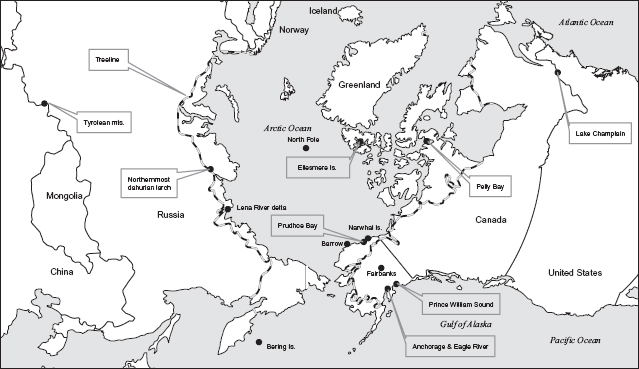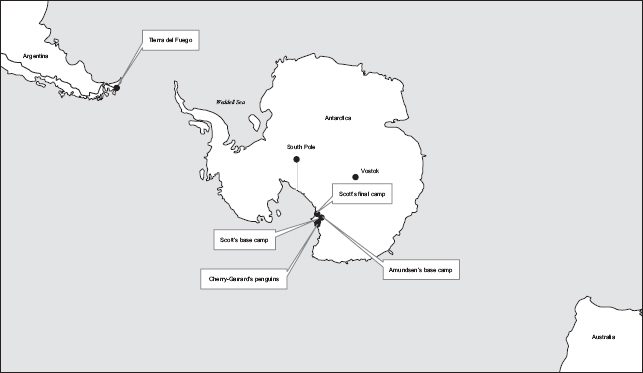Cold (37 page)

It is June nineteenth and fifty-five degrees on Alaska’s North Slope. I drive across the oil fields. The larger lakes remain
half-covered with ice, but the only remaining snow stands in piles deposited by plows. The piles are filthy, laced with dust
and road gravel.
The landscape, though snow-free, remains brown. Arctic foxes, their coats mangy as they turn from winter white to summer brown,
run across tundra soaked by meltwater. Skinny caribou, back from the migration and shedding winter fur, appear mangy, too.
I pass king eiders and loons in now liquid ponds and hundreds of white-fronted geese staggering around on the tundra. Groups
of ten or twenty snow geese forage along the edge of a road near the coast. Over the next twelve weeks, their chicks will
hatch. The flightless hatchlings and their parents will march fifteen miles east across the tundra to feed in salt marshes.
As summer progresses, the goslings will grow and fatten up and learn to fly. They will head south just as the snow starts
to accumulate, staying ahead of the short days and the bitter winds.
On the edge of a gravel road, I listen to a biologist describe his experiments with hibernating ground squirrels. “They look
dead,” he says. “They are curled up. If you uncurl them, and they are alive, they will curl up again. If they are dead, they
will not curl up again.” He collects hibernating animals from the field and takes them back to his laboratory. While they
hibernate, he inserts probes in their brains. He measures their temperature. Funding, he says, comes from the military and
the medical community. In addition to being world-class hibernators, they can, for reasons not fully understood, survive massive
blood loss. Behind him, out of his line of sight on the tundra, a ground squirrel stands on its hind feet, uncurled and vigilant,
posing like a prairie dog. Until a few weeks ago, this squirrel had been nearly frozen, curled up. Farther behind, the Putuligayuk
River flows gently, ice-free, the sudden flush of breakup already over. Between me and the river, wooden piles, left over
from a long-abandoned drilling operation, have been frost-heaved out of the ground. Little mounds of gravel cover the tops
of the piles several feet above the ground. Between the piles with their mounded gravel, male plovers dance about, spreading
their wings and hopping above sprigs of grass, hoping to attract females. It has been said that they fly halfway around the
world with no greater purpose in mind than sex. It might be better said that they fly halfway around the world with no lesser
purpose in mind than sex. With sex out of the way, they will fly south again, leaving to the females the responsibilities
of nesting, egg sitting, feeding of young, and flight school.
I drive toward the coast to meet a group intent on releasing a seal. The seal was found inland months ago with its jaw broken
and its flippers and face frostbitten. It was captured, flown south, and treated. Today it is to be set free. It shows up
in a plastic dog kennel of the sort used to fly pets. Two biologists carry the kennel from the back of a truck and place it
on a gravel beach. An oil field worker wearing a hard hat and an industry-issued fireproof work jacket unlatches the door.
The seal, seemingly suspicious, sniffs the air. It shuffles a flipper length forward and looks around. It shuffles another
few flipper lengths and stops to look around again. Its eyes are brown spheres of the sort that would melt the heart of the
most field-hardened biologist. Its body is that of a Butterball turkey, almost as wide as it is round. An orange satellite
transmitter has been glued to its back and will stay there until it sheds its fur next spring. It breaks for the sea, shuffling
hastily across the remaining few feet of gravel. It plunges into a light chop. It swims, then pauses. Head up, it looks out
toward the sea ice, perhaps a mile to the north. It turns to bless us once more with its brown-eyed gaze, then submerges,
dipping like a submarine. When it reappears a few minutes later, it is heading due north, toward the sea ice. Toward home.

Warm water is less dense than cold water, and hence warm water floats on top of cold water. Freshwater is less dense than
salt water, and hence freshwater floats on top of salt water. Water warmed in the tropics floats on the colder underlying
water and spreads out to the north. As it spreads, it loses heat. A portion of it evaporates, and it becomes increasingly
salty. By the time it reaches the North Atlantic, it has lost enough heat and become salty enough to sink. The sinking water
spreads south across deep ocean basins. It may not rise again for a thousand years.
This movement of ocean water has been called the conveyor belt. The belt conveys the equivalent of one hundred Amazon Rivers
and carries enough heat to warm western Europe. Without this belt, Berlin might be as cold as Edmonton. Without this belt,
Scottish sheep might be grazing hip-deep in snow.
Great Britain’s former prime minister Tony Blair, advised by scientists, began to worry about sudden changes in climate, about
what more and more specialists were thinking of as catastrophic tipping points. One thing he might have had on his mind was
a conveyor belt breakdown. As polar ice melts, it dumps freshwater into the North Atlantic. North Atlantic water is cold and
salty, so it sinks, and in sinking it powers the conveyor belt. Melted ice is not salty. It will not sink as well as the cold
salty water of the North Atlantic. By not sinking, it will slow the conveyor belt. With the greenhouse effect and global warming,
western Europe will warm for a time, but if the conveyor belt slows, western Europe may suddenly cool down. British farmers,
it has been said, may have to learn to grow crops in snow. Blair may have been worried, too, about the tipping point of the
ice itself. For the three decades since satellites have been in place to watch the poles, more than a quarter of the once
permanent pack ice has disappeared. The melting of ice, the weakening of the hydrogen bonds that hold water molecules in the
lockstep crystalline structure of ice, requires a great deal of heat, but that heat does not change the temperature of the
ice or water. The heat does nothing more than weaken the hydrogen bonds between molecules. A one-square-mile block of ice
measures thirty-two degrees just before it melts. Apply heat until the one-square-mile block of ice melts, and the pool of
liquid water will measure thirty-two degrees. Apply the same amount of heat needed to melt that block of ice to the pool of
liquid water and the water temperature will rise one hundred and seventy-six degrees. After the ice is gone, after the hydrogen
bonds are weakened, after the solid collapses into a formless liquid: add heat and the temperature soars.
And Blair may have worried, too, about methane. As permafrost melts, as Arctic tundra warms, the methane trapped in soil will
be released into the atmosphere. Methane is twenty times more effective at trapping heat than carbon dioxide. In 2005, scientists
looking at Russian permafrost reported melting. What had been frozen peat was becoming a landscape of mud and lakes. An area
the size of Germany and France combined could be poised to release seventy billion tons of methane. More would come from Alaska
and Canada and various mountain peaks. Sergei Kirpotin at Tomsk State University in western Siberia called the situation “an
ecological landslide.” David Viner, a senior scientist at the University of East Anglia in England and part of the Russian
permafrost project, said, “There are no brakes you can apply.”

It is June twentieth, the eve of the summer solstice, on Alaska’s North Slope and 60 degrees Fahrenheit, or 16 degrees Celsius,
or 289 Kelvin. Said another way, it is 520 degrees Fahrenheit above absolute zero.
A man tells me of a musk ox frozen in the sea ice, standing up, thirty miles west of here. I find this hard to believe. He
produces a photograph. The ox is indeed standing in ice and frozen. Its head hangs low, in the normal posture of a musk ox,
but its breath has formed a frozen pedestal. It reminds me of the stories of cattle frozen during the School Children’s Blizzard.
The difference is that here the ox will fall into the Beaufort Sea as the ice melts. The man with the photograph is worried
that the carcass, melting, will attract polar bears.
I stand on the western edge of Prudhoe Bay at the spot where I swam almost a year ago, on the first of July. Here the ice
remains hard up against the shore. It is rotten ice, very nearly the kind of ice called
aunniq
by the Inupiat, but without holes of open water. Swimming is out of the question anywhere nearby. The ice stretches out across
Prudhoe Bay and to the north, ragged and in places dirty, in places cracked, in places heaved up into miniature pressure ridges.
Brownish blocks of ice stand above the frozen surface like glacial erratics. The blocks cast shadows that look like seals,
but I see no actual seals.
I think for a moment of Father Henry living in his ice cave, of the caterpillars just becoming active on the tundra, of Adolphus
Greely. Tomorrow will mark the anniversary of Greely’s salvation. Sergeant David Brainard, one of the survivors of Greely’s
expedition, did not record a journal entry on June twentieth. He did, however, write an entry for the twenty-first, about
nine hours before the rescue ship sailed into view: “Our summer solstice! The wind is still blowing a gale from the south.
Temperature 7 a.m. 31°, minimum recorded 28°.” He ate lichen stew and boiled sealskin that day. “Since the day before yesterday,”
he wrote, in a comment that would be echoed in the journal of his savior, “Elison has eaten his stew by having a spoon tied
to the stump of his frozen arm.” At eight thirty in the evening, the rescue ship steamed into sight. Brainard, Greely, and
four others returned to civilization and family and careers. Elison, taken aboard the rescue ship but too far gone to be saved,
died in Greenland on July 8, 1884, just seventeen days after the rescue.
At this moment, there is just enough breeze to keep the mosquitoes down. I consider applying sunscreen to my ears and nose.
I look out across the sea ice. Through binoculars, I have to look well offshore to find pockets of open water. There will
be no walking to the North Pole today, but the arrival of a rescue ship would also be out of the question.
With a perverse desire to swim, I consider driving to the other side of Prudhoe Bay, to the open water where the seal was
released. But I decide against it. Instead, I stand next to the ice, worn out from a long winter, enjoying the breeze and
the view of the sea ice, simultaneously disappointed and thankful that it remains too cold for swimming.

Looking Down on the Northern Hemisphere
Geographic illustration prepared by Bill Lee
